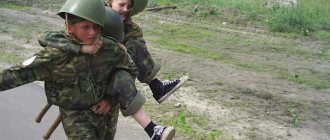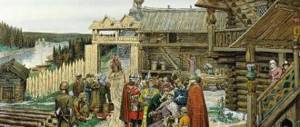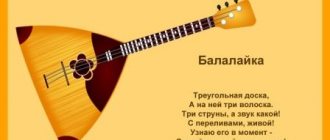Slide captions:
Christmas carols: history and traditions. Completed by: teacher Borovik Yana Igorevna MBDOU “Kindergarten No. 6”
From the history of the holiday Kolyada - this was the name of the ancient Christmas ritual of glorifying the holiday of the Nativity of Christ with songs, as well as the song itself. In Rus', on winter evenings, when it was completely dark, Kolyada walked from house to house - in an inside out fur coat, with an animal mask on her face, with a grip or a stick. “Kolyada was born on the eve of Christmas,” the carolers, the village boys and girls, sang outside the windows.
Once upon a time in Rus', Kolyada was not perceived as a mummer. Kolyada was a deity, and one of the most influential. They called out for the carol and called out, as they did in relation to the lesser deities - Tausen and Pluga. The days before the New Year were dedicated to Kolyada, and games were organized in her honor, which were subsequently held at Christmastide.
In Siberia, in the Yenisei region, carolers sang “Vinogradye” at Christmas. A choir of teenagers and sometimes adult “guys” set off with a star in their hands under the windows of the huts. First, permission was sought from the owners to sing “Vinogradye.” If allowed, the crowd entered the hut with words of gratitude: Like a master in a house, like a master in paradise; Like a mistress in the house, like a bee in honey, Little children in the house, like pancakes in honey...
If the carolers were not allowed in, they would pick up something completely different: “The master is in the house, like the devil is in hell,” etc. Usually, in each hut, the carolers found cordiality and hospitality. After addressing the householders and their children, the singer and choir sang “Vinogradye.”
The star carried by the carolers depicted a stormy sea, a ship and heroes on it. The middle of the star was made from a sieve box, into which a drawing of a ship and a candle were inserted; the outside of the box was covered with oiled paper and the corners with fringe. The star was placed on the handle.
Yuletide fun and amusements Began on the second day after Christmas Masks were made, which were called mugs and faces For masquerades they dressed up as bears, goats, blind lazars, fighters, old women and even hens - the sleeves of an inverted sheepskin coat were pulled over the legs, the hooks were fastened on the back, half-bent A mask with a comb was put on the head, and the tail was tied behind.
On New Year's Eve, the mummers drove a "filly": two guys were tied back to back, the front one held a pitchfork with a horse's straw head on it. The “filly” was covered with a blanket on top, on which the boy rider sat. The image of a horse, of course, was very dear to the peasant farmer.
During the day at Christmas time, sleigh rides were organized. Arc after arc of fifty sleighs lined up as a train. In Siberia, trotting races were in use: pacers and trotters raced like a whirlwind to the whooping of daredevils.
Yuletide fortune-telling On Epiphany, fortune-telling was performed for the last time. Various methods of predicting fate include throwing shoes over the gate: “Where the sock points, you will be married in that direction.”
Children, young boys and girls began caroling. They sang carols under the windows of the huts and received various treats for this.
The most common carols were comic choruses, where the girls sang: A carol was born on Christmas Eve Across the fast river... And the guys sang along: So that the king's treasury of gold May be full forever, So that the glory of great rivers will rush to the sea. Small rivers - to the mill. And we sing this song to bread, We sing to bread, we give honor to bread.
Carols: Carols, carols, Christmas Eve! Good auntie, It’s a sweet pie, don’t cut it, don’t break it, serve it quickly, to two, three, we’ve been standing for a long time, but we can’t stand it! The stove is heating up, I want some pie!
The little boy sat down on a sheaf. He plays the pipe and makes fun of the carol. Shchedrik-Petrik, Give me a dumpling, a spoonful of porridge, a ring of sausage. This is not enough. Give me a piece of bacon. Take it out quickly, don't freeze the children.
You, owner, don’t be tormented, give it quickly! And like the current frost, it doesn’t tell you to stand for long, it tells you to serve it quickly: Either pies come out of the oven, or a penny of money, or a pot of cabbage soup! God give you a yard full of bellies! And to the stable of horses, To the stable of calves, To the hut of the children And to the care of kittens!
Mister, gentlemen, Mister's wife, open the doors and give us a gift! Pie, roll or something else!
Carols and the ritual of caroling, calendar ritual songs of the Slavs - presentation
Carols and the ritual of caroling
Terms Kolyadki (kolyadki, carol songs) are calendar ritual songs of the Slavs, performed mainly during the Christmas period, during ritual rounds from house to house. Caroling is a Slavic ritual of visiting houses, primarily dedicated to Christmastide, by a group of participants who performed “well-wishing” sentences and songs addressed to the owners of the house, for which they received a ritual treat.
Types All carols can be conditionally divided into “Christ-glorifying” (Christmas) and “sowing” (pagan). The first ones are dedicated to the Nativity of Christ, these are the carols to which we are accustomed.
Types II, as a rule, are more archaic, associated with the pagan cult of fertility. Their main content is wishes for harvest and prosperity in the new year. Pagan carols reflected dependence on natural forces and, in fact, were an appeal to them, the gods responsible for the harvest, because the life of a medieval peasant directly depended on the harvest.
Kolyada The word “Kolyada” itself is a name. This was the name of one of the fertility goddesses in the Slavic pagan pantheon, whose holiday was celebrated on the day of the winter solstice.
Key ritual Initially, caroling (as one of the key rituals of the Kolyada holiday) began at the end of December immediately after the holiday. These are still ancient times. Then the traditions changed and the time of carols was moved (just like Christmastide).
Later, it was customary to sing carols three times during Christmas time: on Christmas Eve (January 7th), on New Year's Day (now the 14th day) at Epiphany (January 19th). But most often we went to caroling on the 7th. "The Night Before Christmas" comes to mind.
Dressing up Dressing up is a serious ritual; people prepared for it in advance: they made costumes and masks. It was very important that the costume was made by hand (especially the mask) and from natural materials. The general meaning of the ritual was to look unusual, wonderful, and best of all, creepy. That’s why they tried on different guises, and then acted out scenes typical of the chosen characters.
Mummers In the process of caroling, the mummers were divided into small groups of gangs. They usually did not enter the house, and before starting to sing carols, they asked permission from the owners. Like, “Can I call Kolyada?”
Mummers If the owners of the yard gave the go-ahead, then the carolers began their theatrical performance. As a rule, they sang songs addressed to the owners of the courtyard. Moreover, the songs are laudatory, sometimes even too laudatory. They played various instruments, danced, and sang ritual songs and wishes. After all this, the mummers should have been generously treated.
Ban After the Baptism of Rus', traditional Slavic rituals began to be banned as sinful. The ban on caroling and worship of Kolyada was introduced in 1684. But they continued to carol anyway. Carols and the celebration itself were moved to other dates (closer to our Christmas, that is, to January). The custom of dressing up and having fun from the heart has become unclean. The carolers began to behave more quietly and less cheekily. “Pagans” were not even allowed into the yard.
If earlier people glorified Kolyada, now people walked around the courtyards and glorified Christ. A so-called “nativity scene” (a two- or three-tier box) appeared. Now the carolers also carried it with them, acting out scenes from the life of Christ and the Saints.
Slide Master Free Powerpoint Templates Visit to: Select Categories & Colors & Popular Templates Select your liked template designs Download free and use it your presentation. And Share our website. Group Presentation Overview -Project Description Text -Sub Topic 1 -Sub Topic ABC -Sub Topic 123







